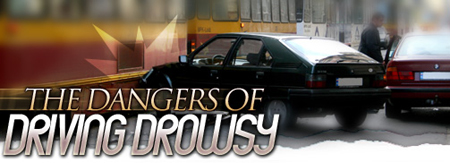
Driving
Drowsy Adds Danger to the Roadways
Chances
are the driver swerving in the lane ahead of you might not be driving drunk after all,
but instead, driving while drowsy.
The alarming trend of driving while
drowsy continues to bring increased danger to roadways across America. According
to statistics from the AAA Foundation for Traffic Safety, more and more drivers
are now hitting the highways with inadequate sleep. In the last 10 years, AAA
estimates that nearly every police officer watching the roadways has pulled over
suspected drunk drivers only to find they were merely drowsy.
A 1994 survey
conducted by the National Highway Traffic Safety Administration (NHTSA) found
that up to 100,00 police-reported crashes annually involve drowsiness or fatigue
as a principal causal factor. According to NHTSA data, that accounts for 1.5 percent
of all crashes. The NHTSA estimates these figures have only grown over the last
10 years.
On average, studies have found that at least 71,000 people are
injured in fall-asleep crashes each year, with an estimated 1,500 deaths annually
from drowsy driving. These figures, according to the NHTSA, total nearly $12.5
billion in monetary losses every year. Mounting evidence from the AAA Foundation
suggests the numbers are continuing to grow higher and more dangerous. The
Dangers of Driving Drowsy -
89 percent of police officers agree drowsy driving is just as dangerous as drunk
driving
- 93 percent of police officers
believe drowsy driving is becoming as serious a problem as drunk driving
- 93
percent agree drowsy driving is a problem for passenger car drivers
- 97
percent agree drowsy driving is also a problem for commercial drivers
- 95
percent agree drivers who cause a crash because they are fatigued should be charged
with a driving violation
- 96 percent
agree more education is needed to inform drivers about the dangers of drowsy driving
According
to Peter Kissinger, president and CEO of the AAA Foundation for Traffic Safety,
police organizations across the country are trying to educate people about the dangerous
effects of drowsy driving.
"Through releasing the results of our drowsy
driving survey, we hope to raise public awareness on this important issue,"
Kissinger said. "The AAA Foundation's free brochure, "Wake
Up!," also helps drivers by providing tips to understand the risks
and symptoms associated with drowsy driving which are key to avoiding it."
Richard Gelula, CEO of the National
Sleep Foundation (NSF), says many drivers aren't aware of just how
dangerous they are behind the wheel when drowsy.
"Promoting safe,
healthy sleep practices to avoid drowsy driving is necessary to decrease its occurrence,"
Gelula said. "Through our site, we are spreading the word about the importance
of sleep and being alert behind the wheel."
According to the NSF,
it's working to debunk so-called remedies to drowsy driving such as rolling down
the window and turning up the radio. These unhelfpul tips are just making drowsy
driving even more dangerous.
Assistant Commissioner Earl M. Sweeny, chair
of the Highway Safety Committee of the International Association of Chiefs of
Police, said police are seeing more and more drivers who take to roadways fatigued
and tired. Departments across the country are now working to tackle this growing
highway danger.
"We were quite eager to assist the AAA Foundation
in spreading the word among police officers to participate in their drowsy driving
survey," Sweeny said. "As police officers, we are exposed to the real
world issues affecting drivers and, as such, it makes a lot of sense to ask police
officers about their experiences."
A recent NHTSA-sponsored Gallup
survey found that 95 percent of the driving population considers drowsy driving
by other people to be a threat to their safety. However, about 37 percent of respondents
reported they had fallen asleep while driving at least once in their life. An
additional 10 percent of respondents, an estimated 7.5 million drivers, had done
so within the month preceding the survey.
In a study commissioned by the
AAA Foundation, researchers from the University of North Carolina Highway Safety
Research Center recently investigated the experiences of a sample of drivers who
had been involved in drowsy driving crashes. Twenty-five percent of drivers who
had fallen asleep at the wheel, and about 33 percent of those in crashes attributed
to fatigue, reported sleeping an average of less than six hours per night. In
comparison, about 11 percent of drivers involved in crashes unrelated to fatigue,
and less than 7 percent of drivers not involved in crashes, reported sleeping
so little.
Tips
to Avoid Driving Drowsy - Do
not drive when you are sleepy
- Stop
driving if you become sleepy while on the road
- Drink
a caffeinated beverage
- Since it takes
30 minutes for caffeine to enter the bloodstream,
take a 20-30 minute nap while waiting for the caffeine to take effect
- Get
at least six hours of sleep the night before a long trip
- Do
not plan to drive all night if you have already worked all day
- Travel
at times when you are normally awake
- Stay
overnight somewhere rather than driving through the night
- Avoid
driving during sleepy times.
- Take
an afternoon nap and find a place to sleep between midnight and 6 a.m.
- Travel
with an awake passenger
- Take a break
every two hours or 100 miles
Learn
more about the AAA Foundation's drowsy
driving survey.
Source - AAA
Foundation for Traffic Safety
|